Imagine being able to combine the best of search engine and social media advertising: the ability to have your ads shown to users who are actively searching for products like yours, alongside the capability to promote your products to users passively browsing through their feed.
That's essentially what you get with the Pinterest advertising system and Promoted Pins.
Factor inPinterest’s extraordinary selling power,and it’s easy to see why so many big-name brands regularly use the platform to run ad campaigns.
If you aren’t familiar with Promoted Pins or how to use them, don’t worry. This beginner’s guide to Pinterest advertising will take you through the process of setting up successful Promoted Pin campaigns.
Are Pinterest ads right for your business?
While Pinterest users aremostly women (70%), the platform has also seen a big increase in the number of men signing up as it fast becomes a go-to site for finding and saving ideas and inspiration of any kind.
Pinterest ads, or Promoted Pins, generally work best for merchants who run stores in those industries that dominate Pinterest feeds to begin with:
- Home decor
- Cooking
- Fashion
- Beauty
- Handmade goods
But this doesn’t mean thatonlybusinesses within these verticals can rock Promoted Pin campaigns and see great results. Instead, it may require fine-tuned targeting or a more creative angle. I’ve seen great ads from companies in the education, photography, and even marketing industries.

Social media strategy and planning templates
Ready to get started with your social media strategy? These free, customizable templates give you tools to plan and execute a strategy that connects you with your target audience while keeping your content calendar organized.
Get your social media strategy and planning templates delivered right to your inbox.
Almost there: please enter your email below to gain instant access.
We'll also send you updates on new educational guides and success stories from the Shopify newsletter. We hate SPAM and promise to keep your email address safe.
Are Promoted Pins effective?
Promoted Pins absolutely can and do work for businesses with products and services that are a good fit for the platform.
Keep in mind, however, that evenorganic content on Pinterest can have a lot of sales potential—93% of pinnerssay they use the site to make purchasing plans and research products, and 40% of users have a household income of more than $100k, so they have quite a bit of spending power.
Regarding Promoted Pins specifically, Pinterest says that:
- 1 out of 2 Pinterest users have made a purchase after seeing a Promoted Pin
- 67% of users discovered a new brand or product as a result of Promoted Pins
- Promoted Pins typicallyearn $2 in profit for every $1 spent in ad costs
然而,你的结果将取决于your products, your target audience, and how you approach Pinterest advertising.
How do Promoted Pins work?
Promoted Pins run on an auction system, like many other pay-per-click systems. Advertisers select a Promoted Pin, choose an objective they want to accomplish, and enter targeting criteria. They’ll place “bids” on having their ads shown to their target audience, and those who bid the most could win the placement.
Promoted Pins can work in two different ways, which we touched on above.
1. Your ads can be shown to users who are browsing on Pinterest
In this case, your ad would either be shown to users who are browsing categories that your Promoted Pin belongs to, or in the feeds of users that Pinterest believes would be interested in your product.
This interest is typically gauged based on past behavior on the platform, including the Pins they've saved, though advertisers can target specific users based on things like email lists or recent site visits.
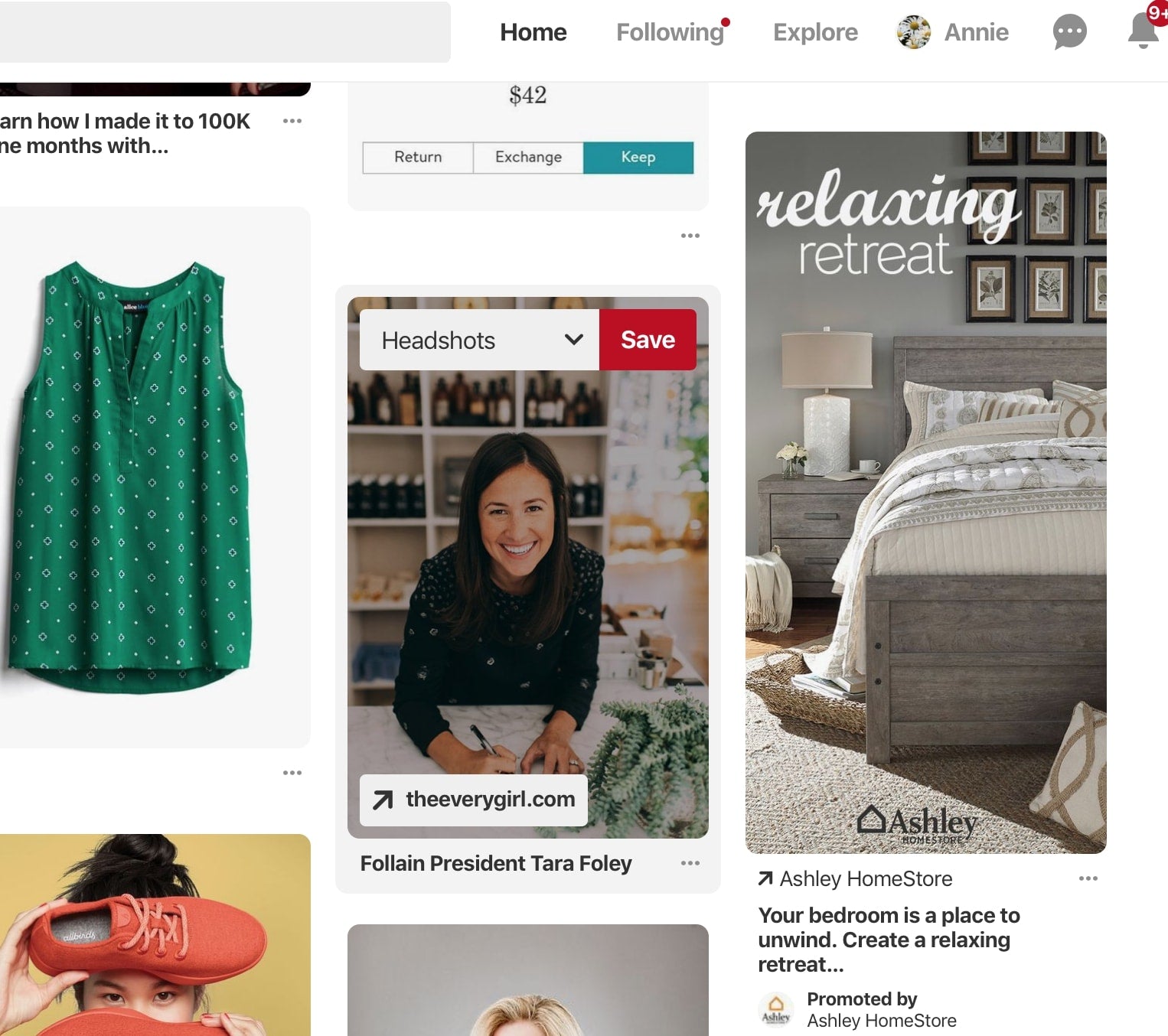
2. Your Promoted Pins can also appear in search results on Pinterest
If someone is searching for “handmade vase” and you happen to sell those, your ad could actually appear in their search results.
As you can imagine, this option lets you promote your products to users who are intentionally seeking them out.
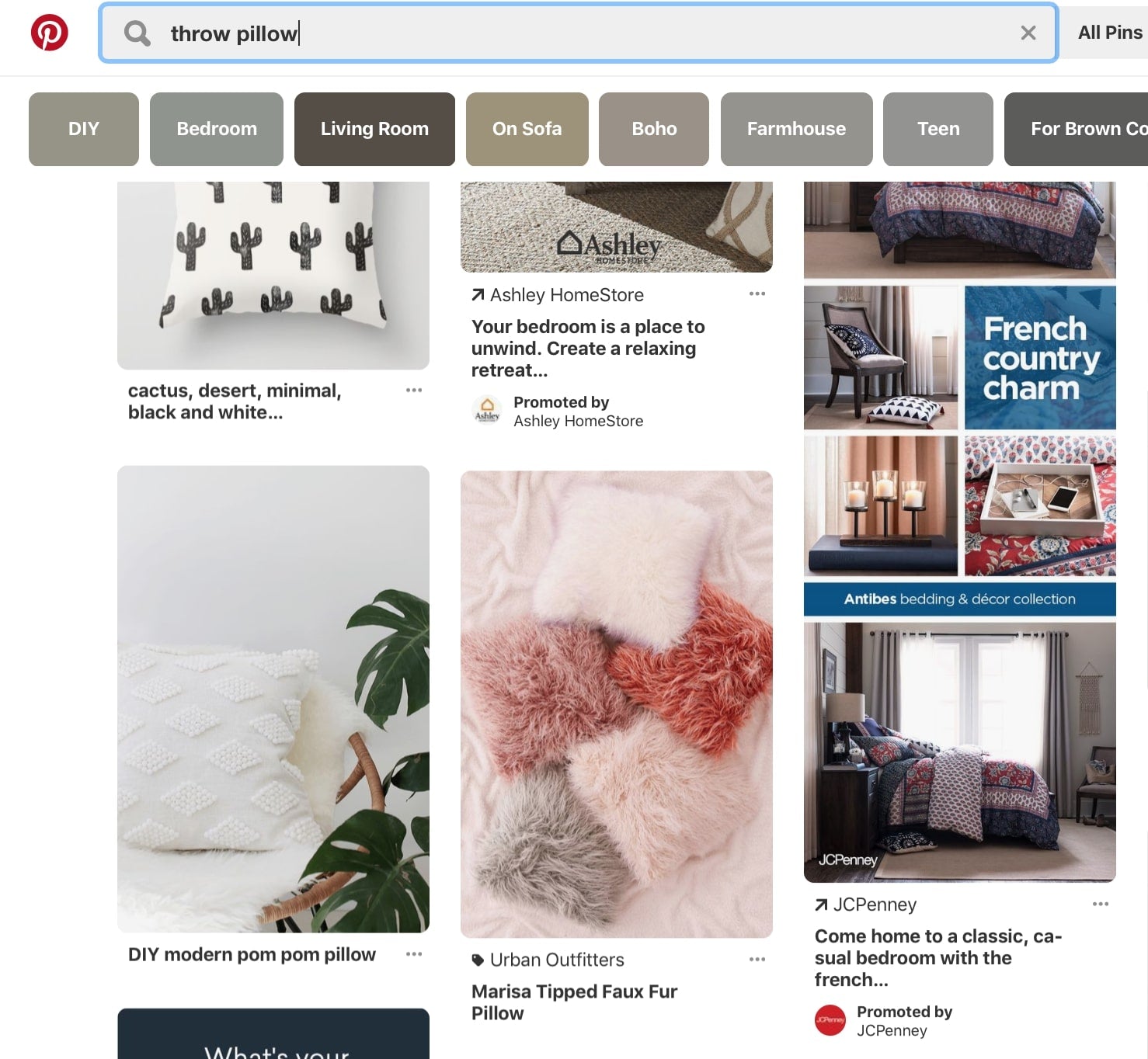
How to create a Promoted Pin
In order to create Promoted Pins, you must have a Pinterest business account. Once you do, you’ll see the “Ads” tab in the top left hand corner. Click on that drop down menu in order to start creating your Promoted Pin campaign. Click “create ad” to get started.
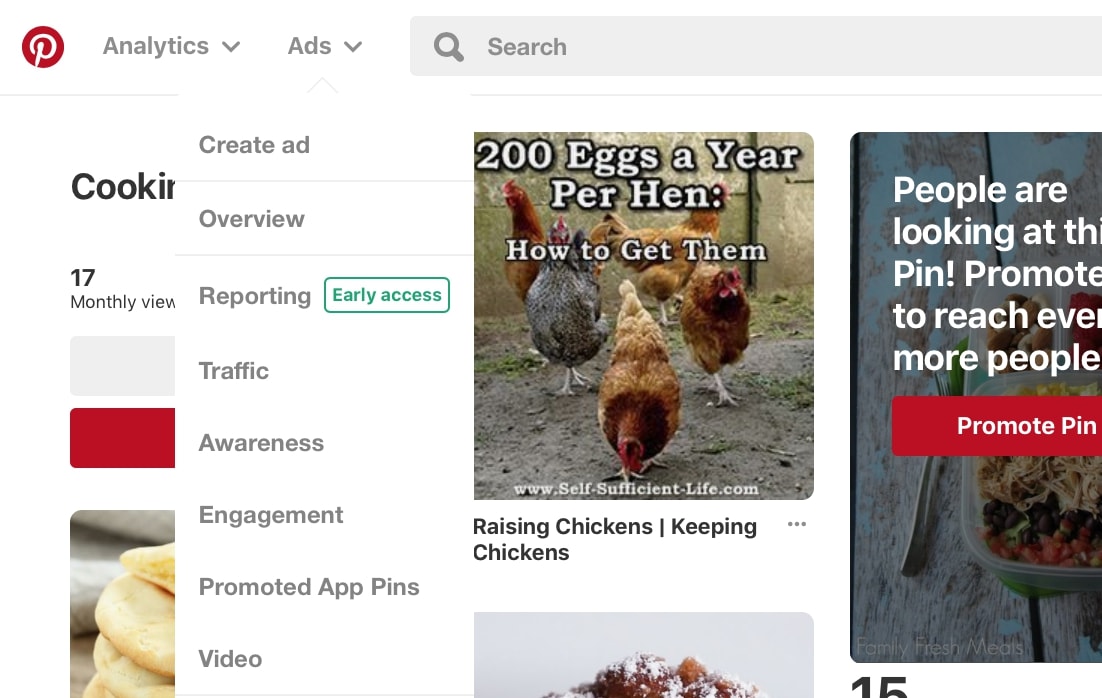
Choose your objective
The very first thing you’ll do is choose your campaign’s objective. These essentially define what you want to get out of the campaign and how you’ll be charged.

Your options are:
- Brand awareness。The goal here is to have your Pin seen by asmany relevant users as possible。You’ll be charged per 1,000 impressions.
- Video views。This is closely tied with brand awareness, and the goal is to build awareness through video. You are charged for impressions as well.
- Traffic。These campaigns seek to drive traffic to your site, though it’s important to note that all objectives still let you do this. With this option, however, you pay per click.
- App install。Encourage users to download your app. You're charged per click.
In this section, you’ll also name your campaign, establish your budget, and decide whether you want to run search ads, browse ads, or both. I often recommend using both, but if you want to stick to one or the other, always enable search ads.

If you’d like, you can always add new Promoted Pins to an old campaign, which lets you have multiple individual ads under a single campaign title. This makes it easier to track everything, so if you’re running a brand awareness campaign for a specific offer or product, keep them together when possible.

Set your targeting criteria
In Step 2 of Promoted Pin creation, you’ll set up your ad group. You can have multiple ad groups under a campaign, and multiple individual ads (the actual Promoted Pins) under each ad group. Ad groups determine targeting, schedule, and a more specific budget.
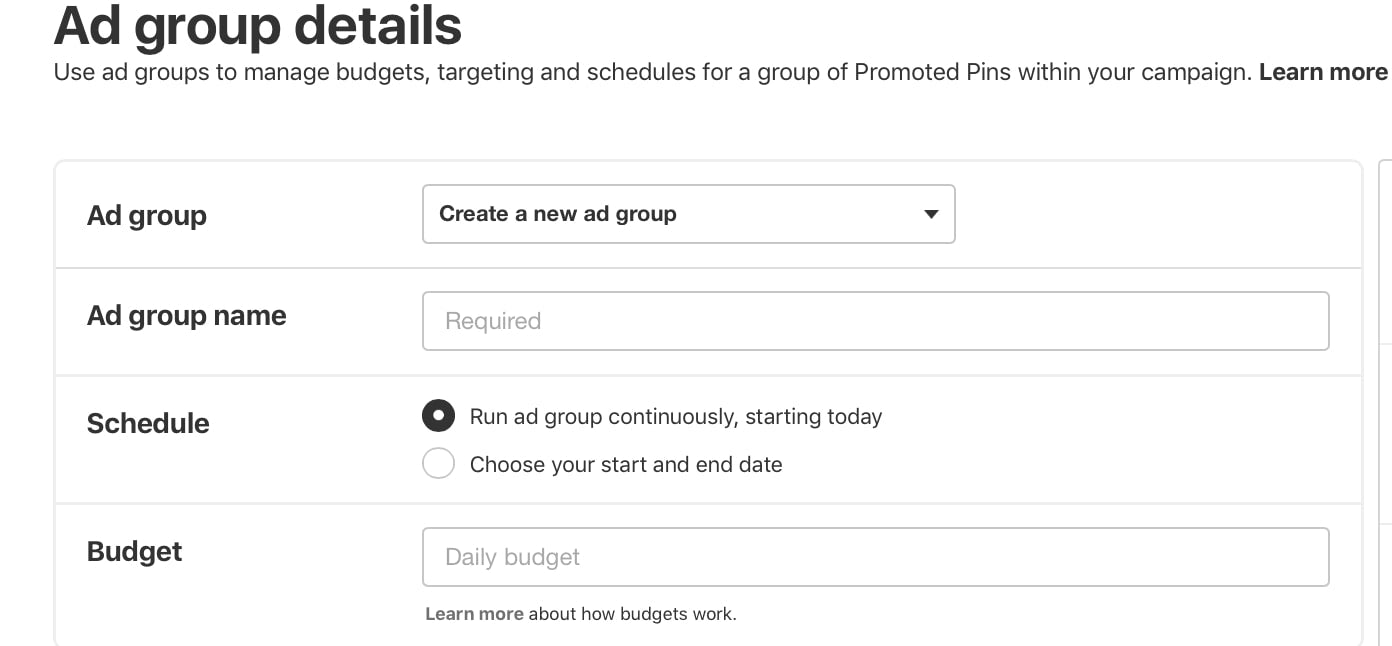
When it comes to the actual targeting, you have several different options of how to proceed.
The first option is tocreate Target Audiences, which work likeFacebook’s custom audiences。You can upload your entire email list (or sections of it), or create audiences based off of recent site activity or users who interacted with a certain Pin.
If you want to reachsimilarusers to any of these audiences, you cancreate an “act-alike” audience, which will show your ads to users with similar qualities.
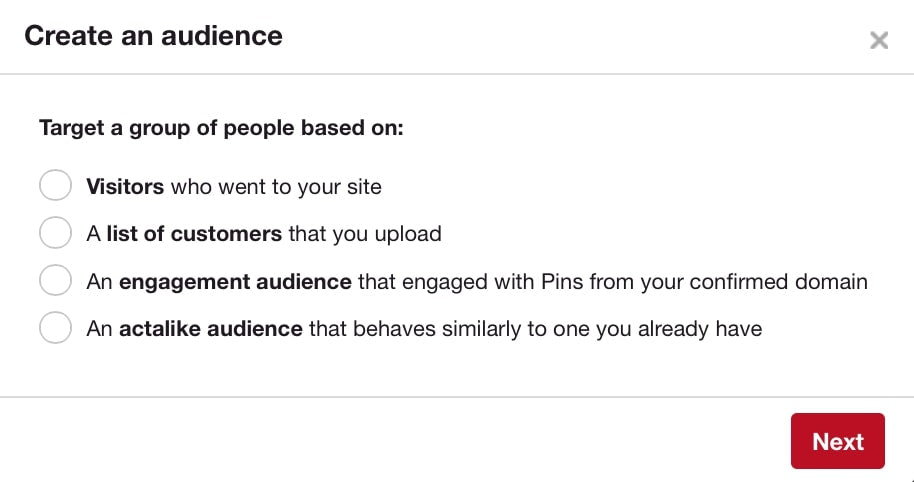
In addition to this option, you can also use any combination of basic targeting criteria likelocation, language, and gender, and morewith interest targeting and keyword targeting.
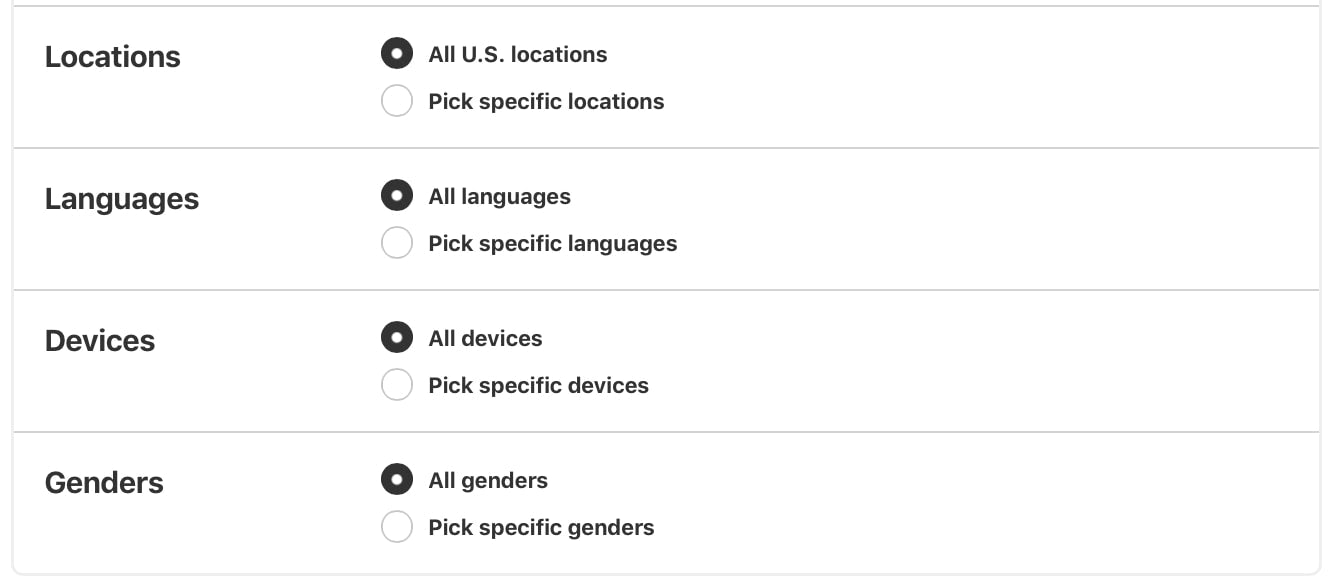
Interest targetingwill affect where your ad shows up for browsing placements when users are either browsing in certain categories or on their home feeds.
You want to choose the interests that are actually related to the Promoted Pin you’re going to select in order to get the best results—even if someone likes photography, they may not be overwhelmingly interested in your Pin about camera lenses when they’re intentionally browsing home decor feeds.
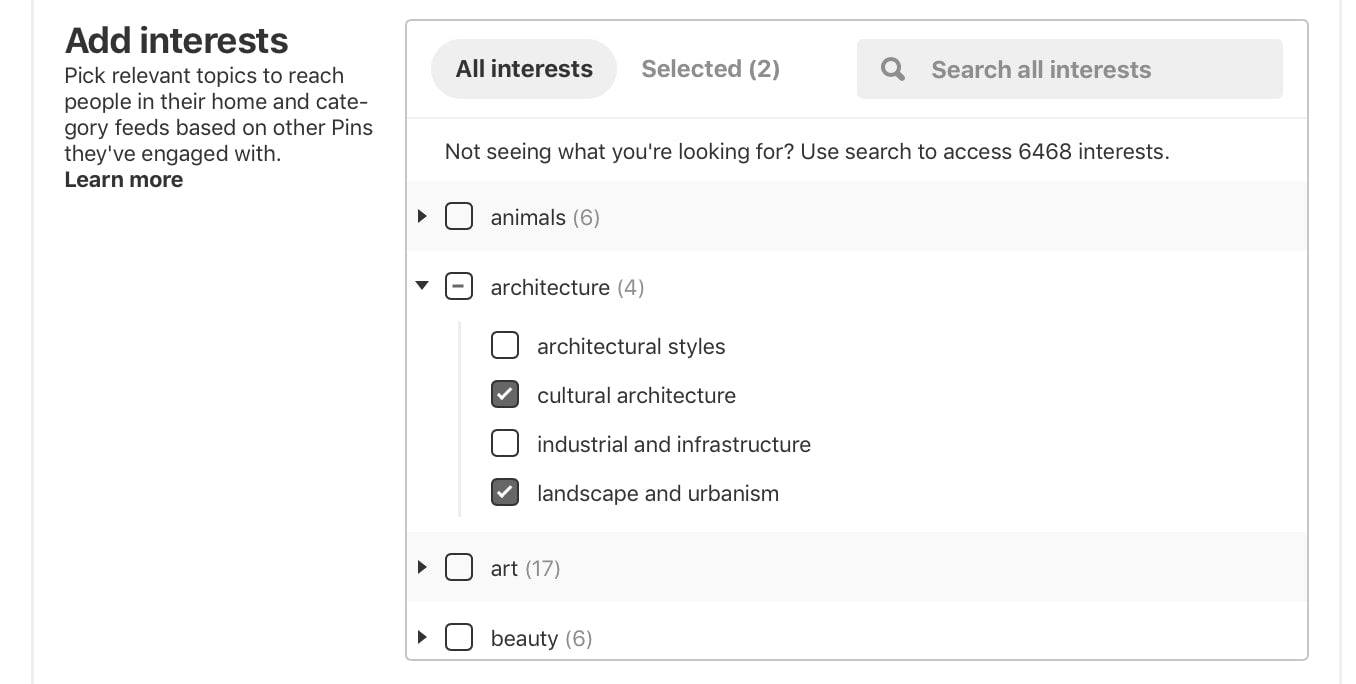
Keyword targetingwill determine which searches your Promoted Pins appear in, and this is the part of the campaign that I probably place the most importance on. Users who are searching, after all, are pretty far along in the buying cycle, and probably closer to actually purchasing.
When you enter in the keywords you want to target, Pinterest will show you a long list of related keywords and their monthly search volumes. This will give you an idea of the potential audience size you could reach.

While it’s easy to just go for the most obvious keywords, I’ve had the best luck when I think outside the box and use a combination of broad and specific keywords.
在上面的示例中,我们使用“蓝莓pancakes.” We’ll obviously want to target “blueberry pancakes” and similar terms, but also “buttermilk pancakes” or “organic blueberry pancakes” or “low sugar pancakes.” You can even go for “breakfast recipe.” If you feel stumped, go ahead and use the keyword tool to get some new ideas.
At the very bottom of this section, you’ll see the option toset a maximum cost per click (CPC)。If you want to ensure that you never pay more for a single impression or click than a certain bid amount, you can enter that here. Pinterest will let you know whether or not it’s competitive.

选择您的销
The last step is to actually choose your Pin. I normally recommend having the Pin in mind before you go through the rest of the process so you can choose the right audience and keywords.
On this screen, you’ll see all of your Pins, and all you have to do to select one is to click it.
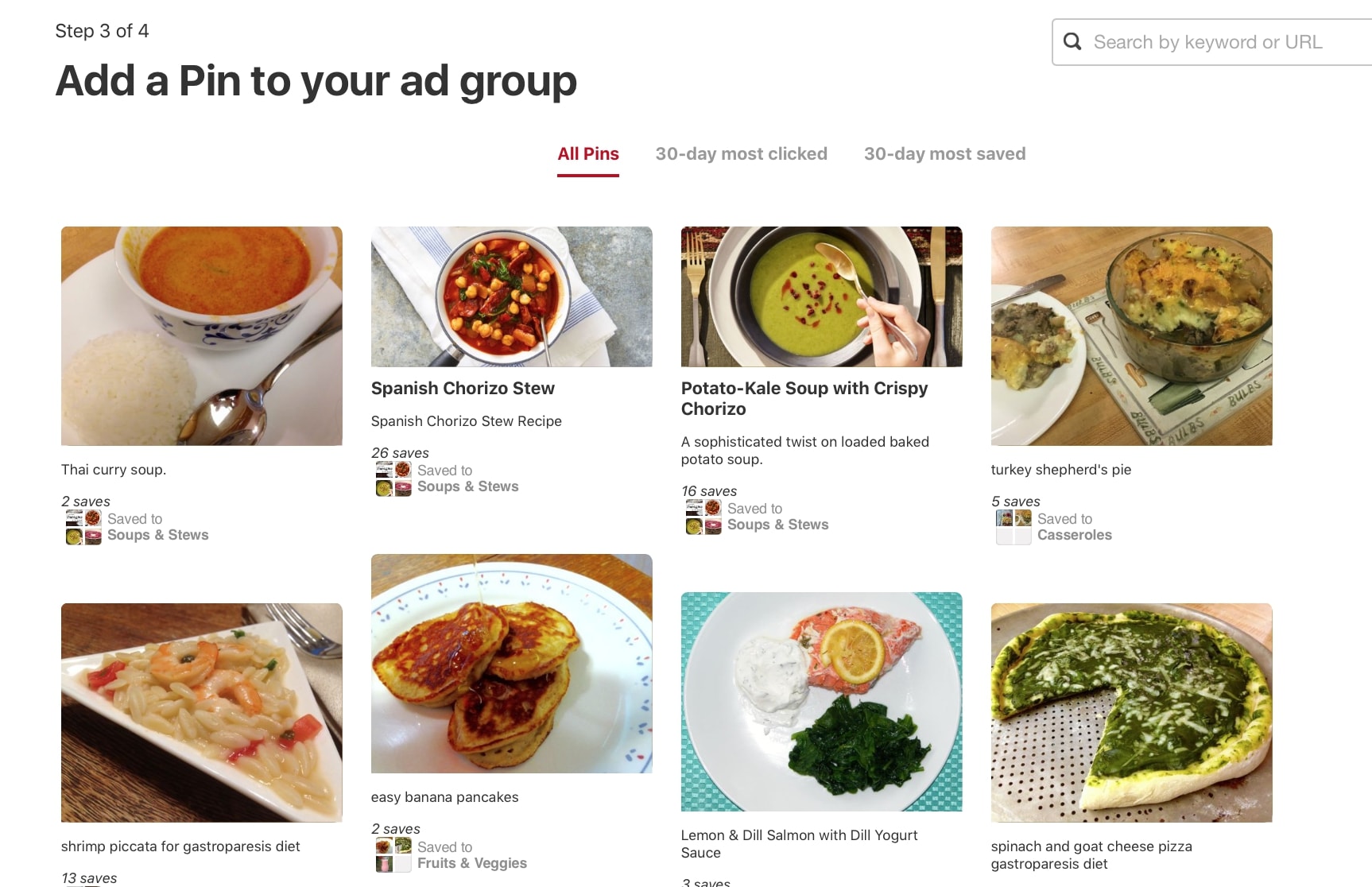
Once you do, you’ll be able to enter the Pin’s name, and establish the specific URL you want to send traffic to.
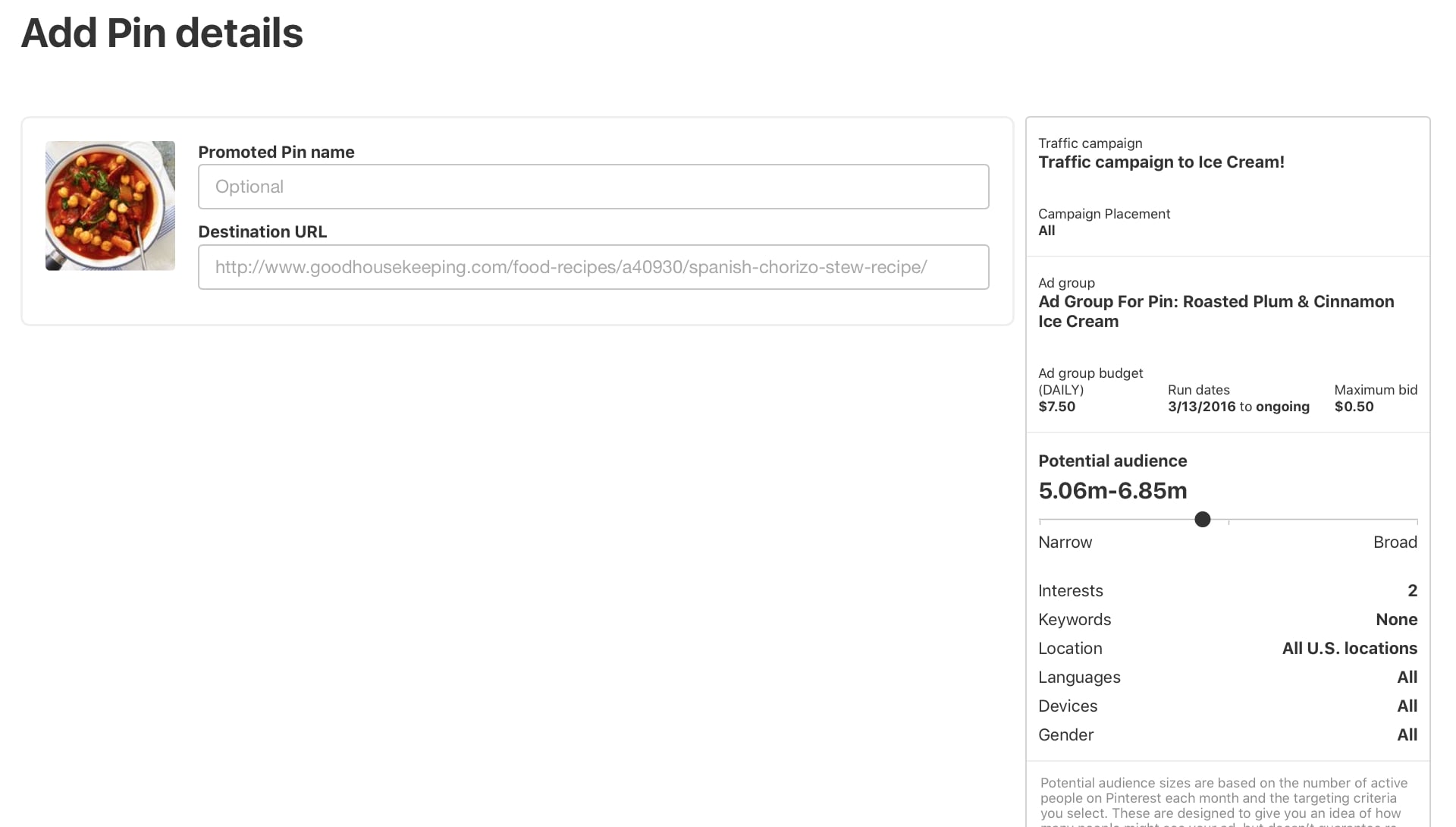
当谈到选择销和deciding which would be best to promote, there are several strategies you can use to make your choice. These include:
- Using Pinterest’s analytics to help you decide, finding your top performing Pins of all-time or within a set time frame. On this screen, you can actually sort Pins by which have been most saved or most clicked on in the last 30 days, giving you an idea of what Pins your audience is most responsible to.
- Strategically create new Pins.If you want to, you can get away with being a little more promotional in a Promoted Pin. A great example of this is app installs. If you want to push app installs, you’ll almost definitely need to create new Pins for it, because you likely won’t have them already in any of your boards.
- Opt for a content-based approach.I remember seeing a recipe for a breakfast parfait and saving it, only to realize later on that the recipe was from Fage, a Greek yogurt brand, and it featured a specific flavor of yogurt none of their competitors had. It was a smart move, because content like recipes and DIY tutorials perform great on Pinterest. If you can feature your products in a similar way, this is a good strategy to try, especially for brand awareness campaigns.
Once you’re all set here, you can submit your campaign for review. Once it’s been approved, it will begin running on the scheduled start date.
Track your results
Once you’re running your campaigns, you can monitor their progress and edit them at any time in the ads manager. You can see which campaigns are running, how much you’re spending, and the results you’ve gotten so far.
Your ad manager can give you the following information:
- Number of impressions
- Number of saves
- Number of clicks
- Click-through rate (CTR)
- Effective CTR
- Average CPC or CPM
- Total ad spend

Image source:Pinterest
If you have the conversion tag in place (which Shopify store owners can enable through the Pinterest Sales Channel), you can eventrack return on ad spend when users convert。This factors in how much the ad cost you, and how much users spent on your site.

Image source: Pinterest
Promoted Pins best practices
If you want to get the most out of your Promoted Pins, here are some best practices and strategies you can apply to create Pins that will stand out in the feed and make users want to click.
1. Test different strategies
wh实验将永远是你最好的朋友en you’re doing any kind of marketing, and this holds up for Promoted Pins as well. Ultimately, there’s no telling what your audience will really respond to and what they may be actually searching for, even if you’ve done your homework.
Because of this, it’s best to test different strategies, Pins, and even targeting options like keywords while you figure out what works best.
Want to run split tests quickly for Promoted Pins?You can now create multiple ads under a single ad group or campaign, and you can duplicate a past campaign and make some changes. This will allow you to test specific factors and see how they affect your results.
2. Make the most out of your description
Your Pin’s image will be what catches the user’s eye, but the description adds a lot of context. It really explains to users what the Pin is and why they should click, so it can make all the difference.
When it comes to Pinterest, it’s better to offer explanations as to why your product is valuable, instead of just stating what the product is.
Let’s look at an example. The Promoted Pin below fromSociety6tells users they have “TONS of throw pillows to choose from.” Okay. Are they great quality? Quirky styles? Essential to me having that Pinterest-worthy living room? This ad doesn’t really make me want to click, even if I’d searched for throw pillows.

This Promoted Pin fromKohls, however, has the type of content that pinners love. It’s offering value, using the context of “how to pick the perfect pillows” in order to promote some of their pillows’ great qualities and show off a few styles. Their description capitalizes on this, saying, “Throw pillows are a fun way to incorporate a little style,” and the image shows users how. This is a great way to maximize your description.

3. Skip the hashtags
Pinterest is already essentially a giant search engine, so hashtags don’t really have a place, even on organic Pins. Users won’t be overwhelmingly tempted to click on hashtags to take them to a new topic, when they’ve likely already searched to get where they want.
Skip the hashtags in your image description and use that valuable copy space for something that will better serve you instead.
4. Choose your landing page carefully
If you’ve run PPC campaigns before on any platform, you know how important the landing page is. You should be sending users directly to the content that they’re expecting to see after they click on your Pin—don’t send them to your home page, or to a random lead offer or email subscriber page.
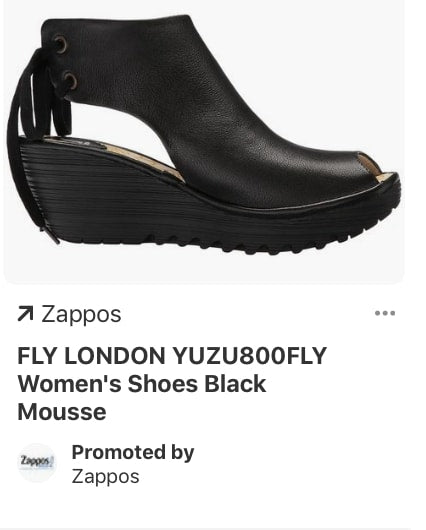
Instead, send them directly to the pages of the products or content you’re promoting. If you don’t, they’ll get frustrated and click away, even if they were interested in buying before. This will lower the chance of them clicking on your ads again, so you don’t want to blow your opportunity.
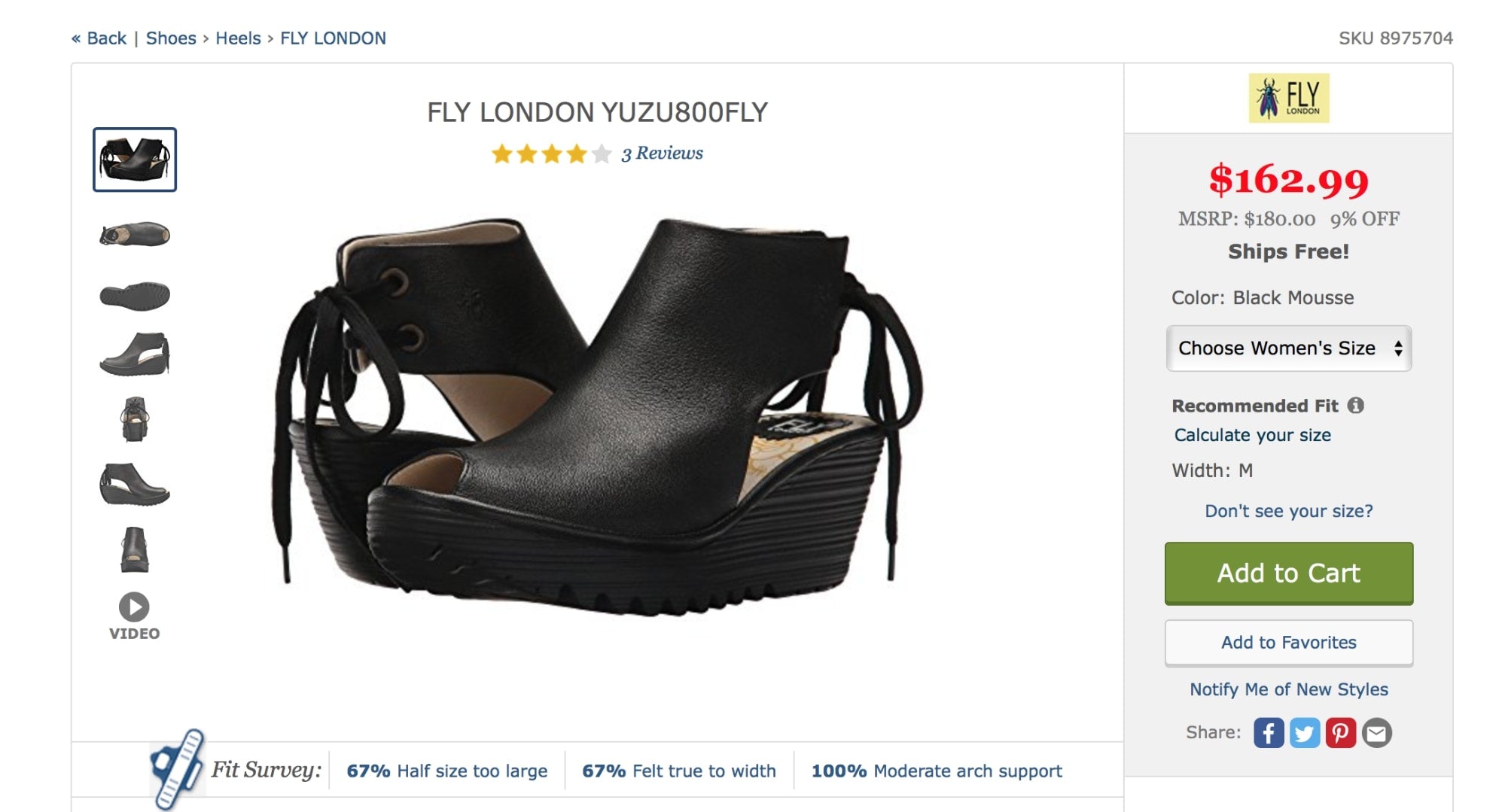
5. Use video
You’ll find “use more video” in the best practices of a lot of blogs talking about marketing, and it’s true on Pinterest too. You don’t see a lot of videos on Pinterest and Promoted Pin videos autoplay on mobile devices, so it will automatically help you stand out.
How-to videos and video content that highlights products briefly both do well on the platform.
When creating video for Pinterest, it should ideally be:
- High resolution.Even if the video is small, if it’s even a little blurry, users aren’t going to click and it will reflect poorly on your brand.
- 上海ort.Pinners are browsing, and they aren’t necessarily ready to sit and watch a ten minute video in the Pin. Instead, it's better to use the Pin as a sort of teaser.
- Not using sound as a crutch.When videos autoplay, they do so without sound. Users can choose to enable the sound, but you’re going to be better off if you can establish context and really reel them in without it. Use on-video text and subtitles for the best results here.
6. Install the conversion tag onto your site
Pinterest’s conversion tagwill give you incredibly valuable information, telling you what actions users take on a siteafterthey’ve clicked on a Promoted Pin. Instead of just measuring the number of clicks, you can actually track how valuable that click was to you.
The conversion tag also lets you track activity on your site period, so that you can set up retargeting campaigns.
The pixel is made up of two different parts: the base code, and the event code. The base code is unique to your Pinterest account, and it lets you build retargeting campaigns based on site activity.
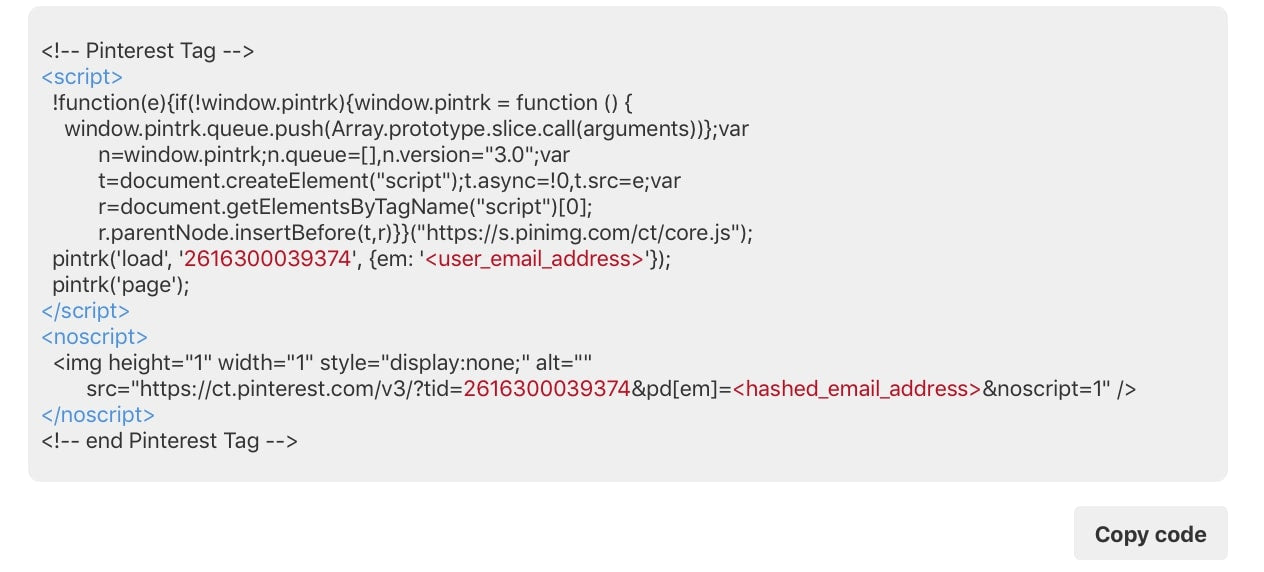
The event codes are attached to the base code on pages where you want to track specific events, like conversions, add to carts, and sign-ups. You would add the checkout tag to the “thank you for your order page,” which might only flag if users purchase, for example.

You’ll be shown the steps above, giving you your base code and then the different event codes, which you can customize and then add to the main tracking snippet.
All pages of your site should have the base code, and you can add specific events to different key pages.
7. Create pins following Pinterest’s recommended dimensions
When you’re scrolling through your Pinterest feed, you’ll notice that Pins come in a variety of shapes and sizes. You’ll get the most attention on your Pin (and the most clicks), however, if you follow Pinterest’s recommended Pin dimensions.

They recommend a Pin image dimension ratio of 2:3, with the image being taller than it is wide. They also recommend going for 600x900 pixels, which will give users the high resolution image that you want them to see.
Pinterest ads: Boost your organic marketing efforts
If you’re still unsure whether or not Promoted Pins are right for you, it doesn't hurt to run a few test campaigns and actually find out.
One important thing to remember is that Promoted Pins shouldn’t be your sole focus in Pinterest marketing; they’ll be much more effective alongside organic campaigns.
They can help you gain a lot of traction on the platform, but if you’re able to get users to discover your content because it’s been repinned by others, for example. that’s a long-term benefit that required no financial investment from you.
So, for best results, put emphasis on both organic and PPC marketing on Pinterest, just like you would with most other platforms.
Looking to get started with organic marketing on Pinterest? Check out ourguide useful Pinterest tools。


